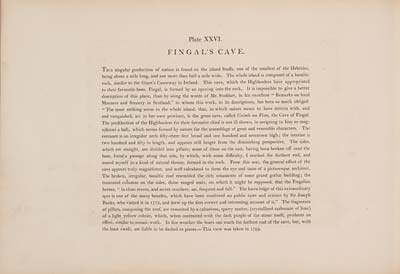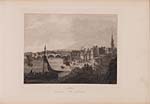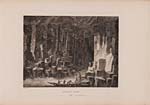(57) Plate XXVI/a
Download files
Individual page:
Thumbnail gallery: Grid view | List view

Plate XXVI.
FINGAL'S CAVE.
THIS singular production
of nature is found on the island Staffa, one of the smallest of the
Hebrides,
being about a mile long, and not more than half a mile wide. The
whole island is composed of a basaltic
rock, similar to the Giant's Causeway in Ireland. This cave, which
the Highlanders have appropriated
to their favourite hero, Fingal, is formed by an opening into the
rock. It is impossible to give a better
description of this place, than by using the words of Mr. Stoddart,
in his excellent "Remarks on local
Manners and Scenery in Scotland," to whom this work, in its
descriptions, has been so much obliged.
"The most striking scene in the whole island, that, in which nature
seems to have striven with, and
and vanquished, art in her own province, is the great cave, called
Uaimh na Fion, the Cave of Fingal.
The predilection of the Highlanders for their favourite chief is
not ill shown, in assigning to him so mag-
nificent a hall, which seems formed by nature for the assemblage of
great and venerable characters. The
entrance is an irregular arch fifty-three feet broad and one
hundred and seventeen high; the interior is
two hundred and fifty in length, and appears still longer from the
diminishing perspective. The sides,
which are straight, are divided into pillars; some of those on the
east, having been broken off near the
base, form a passage along that side, by which, with some
difficulty, I reached the farthest end, and
seated myself in a kind of natural throne, formed in the rock. From
this seat, the general effect of the
cave appears truly magnificent, and well calculated to form the eye
and taste of a picturesque architect.
The broken, irregular, basaltic roof resembled the rich ornaments
of some grand gothic building; the
truncated columns on the sides, those ranged seats, on which it
might be supposed, that the Fingalian
heroes, "in close recess, and secret conclave, sat, frequent and
full." The knowledge of this extraordinary
spot is one of the many benefits, which have been conferred on
public taste and science by Sir Joseph
Banks, who visited it in 1772, and drew up the first correct and
interesting account of it." The fragments
of pillars, composing the roof, are cemented by a calcarious,
sparry matter, (crystallised carbonate of lime)
of a light yellow colour, which, when contrasted with the dark
purple of the stone itself, produces an
effect, similar to mosaic work. In fine weather the boats can reach
the farthest end of the cave, but, with
the least swell, are liable to be dashed to pieces.—This view was
taken in 1799.
Set display mode to:
![]() Universal Viewer |
Universal Viewer | ![]() Mirador |
Large image | Transcription
Mirador |
Large image | Transcription
Images and transcriptions on this page, including medium image downloads, may be used under the Creative Commons Attribution 4.0 International Licence unless otherwise stated. ![]()
| Scotia depicta > (57) Plate XXVI/a |
|---|

